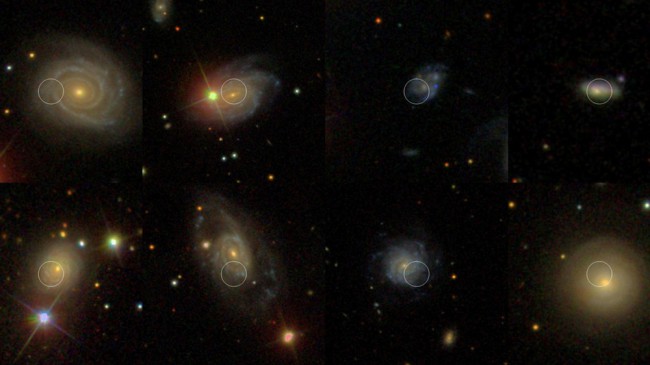A new study analyzes several sites where dead stars once exploded. SDSS
In a new report, scientists show that using a particular class of type Ia supernovae that occur near youthful stars can improve measurements of cosmic distances.
The brilliant explosions of dead stars have been used for years to illuminate the far-flung reaches of our cosmos. The explosions, called type Ia supernovae, allow astronomers to measure the distances to galaxies and measure the ever-increasing rate at which our universe is stretching apart.
But these tools aren’t perfect. In the cosmic hardware store of our universe, improvements are ongoing. In a new report, astronomers identify the best top-of-the-line type Ia supernovae for measuring cosmic distances, pushing other more clunky tools to the back of the shelf.
Using archived data from NASA’s Galaxy Evolution Explorer (GALEX), scientists show that a particular class of type Ia supernovae that occur near youthful stars can improve these measurements with a precision of more than two times that achieved before.
“We have discovered a population of type Ia supernovae whose light output depends very precisely on how quickly they fade, making it possible to measure very exact distances to them,” said Patrick Kelly of the University of California, Berkeley. “These supernovae are found close to populations of bright, hot young stars.”
The findings will help light the way to understanding dark energy, one of the greatest mysteries in the field of cosmology, the study of the origin and development of the universe. Dark energy is the leading culprit behind the baffling acceleration of our cosmos, a phenomenon discovered in 1998. The acceleration was uncovered when astronomers observed that galaxies are pulling away from each other at increasing speeds.
The key to measuring this acceleration — and thus the nature of dark energy — lies with type Ia supernovae, which work much like light bulbs strung across space. Imagine lining up 60-watt light bulbs across a field and standing at one end. The farthest light bulb wouldn’t appear as bright as the closest one due to its distance. Since you know how bright the light bulb inherently is, you can use the extent of its dimming to figure out the distance.
Type Ia supernovae, also referred to as “standard candles,” work in a similar way because they consistently shine with about the same amount of light. While the process that leads to these explosions is still not clear, they occur when the burnt-out core of a star, called a white dwarf, blasts apart in a regular way, briefly lighting up the host galaxy.
However, the explosions aren’t always precisely uniform. They can differ considerably depending on various factors, which appear to be connected to the environments and histories of the exploding stars. It’s as if our 60-watt bulbs sometimes give off 55 watts of light, skewing distance measurements.

